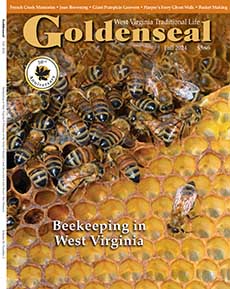Current Issue
Buy the latest issue online or by mail!
Links
- Subscribe by mail
- Subscribe or renew online!
- Issue Gallery
- Back issues available
- Goldenseal Index
- The Goldenseal Book of the Mine Wars
- Contributor Guidelines
- Where to Buy Goldenseal?
Contact Us
(304) 558-0220 extension 134
Monday-Friday
9am-5pm Eastern Time
E-Mail: chgoldenseal@wv.gov
You can also send mail to Goldenseal at:
Goldenseal
The Culture Center
1900 Kanawha Blvd East
Charleston WV 25305-0300
Staff Members
Laiken Blankenship, Editor
(Story proposals, manuscript submissions, photo and story reprint requests, general comments or suggestions)
phone (304) 558-0220 ext. 135
Joseph Aluise, Assistant Editor
(subscriptions, renewals, gifts, address changes, etc.)
phone (304) 558-0220 ext. 134
Goldenseal, the magazine of West Virginia traditional life, is produced by the Department of Arts, Culture and History and takes its stories from the recollections of West Virginians living throughout the state. Oral history fieldwork and documentary photography result in four issues per year with articles on subjects such as labor history, folklore, music, farming, religion, traditional crafts, food, and politics.
History of Goldenseal
GOLDENSEAL was first published in April 1975 by the West Virginia Department of Commerce and the Arts and Humanities Council. Founding editor Tom Screven wrote in the first issue that the purpose of GOLDENSEAL was to “serve not only as a device to preserve many aspects of the state’s traditional life, but also as a means of communication for students and enthusiasts of West Virginia’s folklife.” That remains our mission today.
New in 1975, GOLDENSEAL grew out of an earlier publication called Hearth & Fair, also edited by Tom Screven and published by the West Virginia Department of Commerce. Hearth & Fair was founded in 1973 to promote activities and spread information concerning the Mountain State Art & Craft Fair, held annually at Cedar Lakes conference center, located near Ripley, Jackson County. With a strong emphasis on traditional crafts and craftspeople, Hearth & Fair was published seven times, maturing from its initial eight-page edition in January 1973, to a sophisticated 44-page journal in July 1974. For more information about Hearth & Fair, see “Hearth & Fair: Don Page and the Roots of GOLDENSEAL,” by John Lilly; Spring 2004.
GOLDENSEAL takes its name from a medicinal herb, also called yellow root, among other names. It grows naturally in much of the forested areas of the state, flowering from April through May, and fruiting in July. Goldenseal is a member of the crowfoot family and is valued for its bright yellow-colored root, which is dried and taken as a tonic, a stomach remedy, or an application for ulcerations, and used as a fabric dye. The name was chosen for the magazine because it represents beneficial things that occur naturally in West Virginia. For more information about the goldenseal herb, see “In Search of the Wild Goldenseal,” by Marion Harless; Fall 1999.
In 1976, GOLDENSEAL’s offices were moved to the new Science and Culture Center, now known as the Culture Center, located next door to the State Capitol building on the Capitol Complex in Charleston. Beginning in July 1977, the magazine was published under the auspices of the new Department of Culture and History, now known as the Department of Arts, Culture and History. GOLDENSEAL is still published by the West Virginia Department of Arts, Culture and History from the Cultural Center in Charleston.
In its early years, GOLDENSEAL was funded entirely by the state and was distributed for free to anyone interested in receiving it. Circulation grew from a few hundred in the earliest days to more than 30,000 readers at its peak. The magazine also grew from the 40 pages of the premier issue to its current size of 72 pages by July 1979.
Ken Sullivan became editor of GOLDENSEAL with the April 1979 issue. He remained at the helm through the Spring 1997 issue, guiding the magazine through several changes of administration and changes in state budget priorities. Among his many accomplishments, Dr. Sullivan successfully steered the magazine through an extended transitional period from its early incarnation as a state-supported publication, through years of voluntary subscription payments beginning in the fall of 1981, to being entirely self-supporting by 1995.
In 1997, John Lilly followed Dr. Sullivan as GOLDENSEAL editor. Like his predecessor, he served 18 years in the role, retiring with the Summer 2015 issue. From 2015 to 2022, the editor of GOLDENSEAL was Stan Bumgardner. In 2019, Joseph Aluise came on board as the new assistant editor, following longtime assistant Kim Johnson’s retirement. December 31, 2022, Laiken Blankenship took over as the editor of GOLDENSEAL. Today, GOLDENSEAL remains financially free-standing, funded exclusively by magazine sales. We currently have around 7,200 paid subscribers and sell about 1,100 copies per issue at newsstands.

